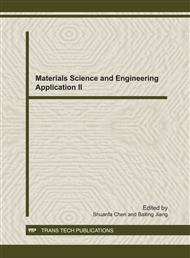[1]
ACI 440. 1R-06, Guide for the Design and Construction of Concrete Reinforced with FRP Bars, American Concrete Institute, Committee 440, Farmington Hills, MI, USA (2006).
Google Scholar
[2]
fib, FRP Reinforcement in RC Structures, Bulletin 40, The International Federation for Structural Concrete (fib), Lausanne, Switzerland (2007).
DOI: 10.35789/fib.bull.0040.ch01
Google Scholar
[3]
Canadian Standards Association International, Canadian Highway Bridge Design Code (CHBDC), CSA-S806-02, Toronto, Ont. (2006).
Google Scholar
[4]
CAN/CSA-S6-02, Design and Construction of Building Components with Fibre- Reinforced Polymers, Canadian Standards Association, Rexdale, Ontario, Canada, (2002).
Google Scholar
[5]
Huang, J., Durability Design of GFRP Bar Reinforced Concrete Members: A New Approach, Ph.D. Dissertation, Syracuse University, Syracuse, NY, USA (2010).
Google Scholar
[6]
Huang, J. and Aboutaha, R., Environmental Reduction Factors for GFRP Bars Used as Concrete Reinforcement: New Scientific Approach, J. of Composites for Construction, ASCE, Vol. 14, Issue 5 (2010), pp.479-486.
DOI: 10.1061/(asce)cc.1943-5614.0000122
Google Scholar
[7]
Huang, J., Durability of Glass Fiber Reinforced Polymer (GFRP) Bar Used as Concrete Reinforcement: Temperature Effect, Applied Mechanics and Materials, Vols. 94-96 (2011a), pp.1573-1576.
DOI: 10.4028/www.scientific.net/amm.94-96.1573
Google Scholar
[8]
Huang, J. Long-Term Performance Prediction of GFRP Bar in Moist Concrete under Sustained Loads, Advanced Materials Research, Vols. 255-260 (2011b), pp.3119-3123.
DOI: 10.4028/www.scientific.net/amr.255-260.3119
Google Scholar
[9]
Huang, J. , Design of Glass Fiber Reinforced Polymer (GFRP) Bar Reinforced Concrete Deck Slab: Strength and Serviceability, Applied Mechanics and Materials, Vols. 99-100 (2011c), pp.1247-1250.
DOI: 10.4028/www.scientific.net/amm.99-100.1247
Google Scholar
[10]
Huang,J., Sustained Load Effect on GFRP Bar Reinforced Concrete Deck, Applied Mechanics and Materials, Vols. 99-100 (2011d), pp.1251-1254.
DOI: 10.4028/www.scientific.net/amm.99-100.1251
Google Scholar
[11]
http: /www. heshuixian. com/dispbbs. asp?boardid=63&Id=2090, Aug. 15, (2011).
Google Scholar
[12]
Dejke, V., and Tepfers, R. , Durability and Service Life Time Prediction of GFRP for Concrete Reinforcement, , FRPRCS-5: Durability of Fibre Reinforced Plastics, Vol. 2, Thomas Telford, London, (2001), p.505–513.
DOI: 10.1142/9789812704863_0079
Google Scholar
[13]
Bank, L. C., Gentry, T. R., Thompson, B. P., and Russell, J. S., A model specification for FRP composites for civil engineering structures, Constr. Build. Mater., 17(6–7), (2003), p.405–437.
DOI: 10.1016/s0950-0618(03)00041-2
Google Scholar


